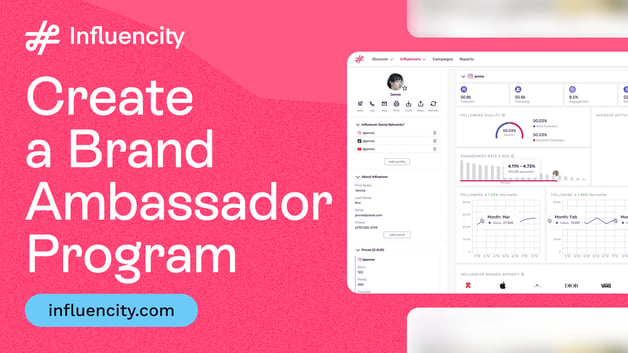10 Tips to Market Your Business on Social Media
If you own a small business or work as a marketing specialist at one, then you may be new to social media marketing. You are probably likely to also have a limited budget to spend on online platforms. These can both be obstacles when it comes to building your presence and getting your name out there. To help you out, in this article we’ll go through how to market your business on social media with 10 tips that can help you sell more.
These 10 marketing tips will give you an idea of the areas you need to focus on in order to raise awareness of your company brand so that you can start building your online reputation and reach a larger audience. So, if you haven’t already, consider including these strategies in your social media marketing strategy.
- Why Your Business Should Be on Social Media
- How to Market Your Business on Social Media
Why Your Business Should Be on Social Media
In today's digital age, having a presence on social media is essential for any business looking to thrive and stay competitive. Social media offers a dynamic platform for businesses to increase their visibility and directly engage with a broad audience. By establishing a social media presence, companies can enhance brand awareness and create a more personable image that resonates with consumers.
Social media is not just about advertising; it’s a multi-functional tool that facilitates real-time communication and feedback from customers, allowing businesses to improve their services and customer relations. This two-way interaction fosters a sense of community and loyalty among customers, which can lead to increased customer retention and referrals.
Moreover, social media platforms provide valuable insights into consumer behavior through data analytics. These insights can help businesses tailor their marketing strategies to better meet the needs and preferences of their target audience. Whether it's through targeted advertisements, promotional campaigns, or interactive content, social media enables businesses to reach potential customers more effectively and at a lower cost compared to traditional marketing methods.
Ultimately, social media is an indispensable tool for modern businesses, offering numerous benefits from enhanced engagement to strategic insights, all of which are crucial for growth and success in today's competitive market environment.
How to Market Your Business on Social Media
Ok, so we’ve seen why these platforms are so valuable. Now let’s get to the heart of the matter: how to market your business on social media.
Here are 10 essential marketing tips and best practices to help you understand how to market your business on social media in an effective and impactful way.
1. Choose the right platforms for your brand
The first step in crafting an effective social media marketing strategy is choosing the right platforms that align with your brand's identity and goals. The choice of platforms is crucial as it determines where and how your content will be shared, directly impacting the reach and engagement of your marketing efforts.
To work out which platforms will work best for you, you need to think about your target audience. Consider the demographics, behaviors, and preferences of your potential customers. Where do they spend their time online? Are they more engaged with quick, witty posts, or do they prefer in-depth informational content? Understanding these nuances is key to selecting the right social media channels.
For brands with a strong visual element—such as fashion, food, or design—Instagram and Pinterest are excellent choices due to their focus on imagery and aesthetics. If your strategy involves sharing video content like tutorials, demonstrations, or behind-the-scenes looks, then YouTube and TikTok are indispensable due to its vast reach and popularity for video content. Meanwhile, if timely engagement or customer service is a priority, Twitter’s real-time communication style might be more beneficial.
Ultimately, choosing the right platform isn’t just about where your content could be seen, but where it will most effectively connect with your target audience.
2. Update Your Profiles
Once you’ve picked your platforms and created your brand profiles, make sure you complete as much information on your page as possible. Select an appealing and recognizable image for your profile picture, include a detailed description in the “About me” section, and add all your contact information. The more information you include, the more professional your page will seem, and the more visible it will be in platform searches, making it easier for potential customers to find and connect with you.
Above all, make sure that your branding is consistent across all platforms to strengthen brand recognition. Regular updates and responding quickly to comments and messages further enhance the professional appearance of your profiles, encouraging engagement and building trust with your audience.
3. Cross-Promote
Another great tip for marketing your business on social media is understanding the value of cross-promotion. Put simply, this is about raising awareness of any other platforms you might be active on, in order to encourage your audience to follow you there too. This could be as simple as posting a link to your profile on another site with a simple call-to-action or including links to your other pages in your profile bio.
Effective cross-promotion leverages the unique strengths of each platform to maximize your overall online presence. For example, you might use Instagram to share high-quality images of your products and then direct followers to your Facebook page for community discussions or support queries. Regularly engaging in cross-promotion not only increases your visibility across different platforms but also provides your audience with varied ways to interact with your brand, enhancing their overall experience and engagement.
4. Add Relevant and Branded Hashtags
The next tip in our “how to market your business on social media” guide relates to hashtags. Add hashtags and keywords that are related to your brand and industry to your page and posts, but don’t overdo it. Hashtags will help you grab the attention of your potential audience by appearing on suggestions and searches
Keep in mind that, although carefully selecting relevant and trending hashtags can significantly increase the discoverability of your content, drawing in new followers and potential customers, it's important to use them strategically—too many hashtags can make your posts look spammy and may detract from the message you want to convey. Aim for a balanced mix of popular and niche hashtags to reach a broad yet targeted audience, ensuring your social media efforts contribute effectively to your marketing objectives.
5. Build a Community
Once you’re all set up and your page has gone live, it’s time to build your community. Instead of focusing on building numbers for the sake of it, try to attract followers who are genuinely interested and engaged in your brand, and interact with them as much as possible. These followers will be far more likely to repost your content, like your posts and, ultimately, convert into paying customers.
In addition, engaging regularly with your audience through comments, polls, and direct messages can help foster a sense of community and loyalty. Take the time to understand their preferences and feedback, as this can guide your content creation and product development. Essentially, tailoring your interactions and content to meet the needs and interests of your engaged followers not only strengthens your relationship with them but also boosts your brand’s credibility and trustworthiness in the eyes of potential customers.
6. Encourage Engagement
Engagement is so important we’re talking about it twice.
Encourage interaction with everything you post. Ask questions. Look for opinions. Reply to comments and repost and comment on other users’ posts. The more you interact with your audience, the more likely they are to become engaged and loyal followers.
Beyond this, regularly involving your audience in your content creation process can also deepen their investment in your brand. For instance, run polls to let them choose between product options or ask for their input on new features. This not only gives them a sense of ownership over your brand but also provides valuable insights into their preferences and needs. Creating a dynamic, interactive environment on your social media channels can transform casual followers into active community members and advocates for your brand.
7. Don’t Over-Promote
Don’t promote your brand with every post. Your aim is to create original content that your followers will enjoy reading. This usually means either educating or entertaining them, not shamelessly promoting yourself at every opportunity. If your followers think you are there purely to advertise a product, then they are likely to lose interest in your brand very quickly. Focus on sharing original content that attracts the interest of your audience.
Ideally, you should strike a balance between promotional content and posts that provide real value. This could include tips, insights, behind-the-scenes looks, or even light-hearted content that resonates with your audience’s lifestyle and interests. By diversifying your posts and prioritizing content quality, you not only maintain engagement but also build a reputation as a brand that truly understands and cares about its community. This approach fosters a stronger, more connected audience that looks forward to your posts and is more receptive when you do promote your products or services.
8. Post Valuable Content
To the same effect, make sure you provide added value with the content you post. Tell your audience something they might not know. Make them laugh. Make them think. Inspire them. The more value you offer, the more followers you will attract to your brand.
Ultimately, consistently delivering content that enriches your followers' lives can help establish your brand as a go-to source within your industry. Whether through educational posts, motivational quotes, or simply entertaining videos, each piece of content should aim to connect on a deeper level. This approach not only enhances engagement but also builds trust and authority. By becoming a resource that your audience depends on for more than just products or services, you create a loyal community that is likely to advocate for your brand and contribute to its growth through positive word-of-mouth.
9. Create Targeted Ads
Targeted ads can be a great tool for expanding your reach and raising awareness of your brand. Targeted advertising is a form of online advertising that focuses on the specific traits, interests, and preferences of a consumer. Define the demographics of your target user then create promotional ads tailored specifically for them. This precision allows you to optimize your advertising budget by ensuring that your messages reach the most receptive audience.
What’s more, by analyzing data such as age, location, browsing habits, and purchase history, you can design ads that speak directly to the needs and desires of potential customers. This personalized approach not only increases the likelihood of engagement and conversion but also enhances the customer experience by providing content that is relevant and appealing. Effective targeted advertising can lead to higher ROI, making it a crucial strategy for businesses aiming to make a significant impact in a crowded market.
10. Try Influencer Marketing
The final tip we want to share relates to influencer marketing. Influencer marketing is a type of social media marketing based on brand endorsements and product mentions from influencers – social media content creators with a dedicated following who are viewed as experts within their niche. This can be a great strategy that can help you build credibility and trust as influencers who align with your brand’s values and aesthetic can extend your reach to a more engaged and loyal audience. This approach not only amplifies your message but also imbues it with the authenticity that comes from a trusted voice in the community.
If you’re new to the world of influencers, an Influencer Relationship Management (IRM) tool is a great place to start. Platforms like Influencity provide comprehensive tools to search for and manage influencers who resonate with your brand ethos. By leveraging these tools, you can streamline the process of identifying, contacting, and collaborating with influencers whose content, values, and audience align with those of your brand. Watching your audience grow as a result of these collaborations can be remarkably rewarding and a significant boost to your brand’s visibility and credibility.
The Power of Social Media to Sell More
Without a doubt, social media marketing has the biggest positive impact on e-commerce. In fact, this industry has seen a dramatic shift in how products are discovered, evaluated, and purchased, largely thanks to the integration of shopping functionalities directly on platforms like Instagram, Facebook, and Pinterest. These platforms have become a showcase for brands, featuring shoppable posts, stories, and ads that seamlessly transition users from browsing to purchasing within a few clicks.
For businesses wondering how to market their business on social media, the key is leveraging these built-in tools to create immersive and interactive shopping experiences. By harnessing the power of rich media content such as videos and high-quality images, e-commerce brands can engage potential customers more deeply, driving both interest and sales. Social media marketing for e-commerce also enables hyper-targeted advertising based on user preferences, behaviors, and demographics, allowing for highly effective personalization of marketing efforts.
Finally, the direct interaction that social media facilitates between a brand and its customers provides instant feedback and fosters trust, which is crucial for conversion. Engaging with consumers in real-time, addressing concerns, and nurturing those relationships turn casual browsers into loyal customers, enhancing both sales figures and brand reputation in a competitive e-commerce market.
Tags:






















%20and%20How%20Can%20They%20Benefit%20Your%20Brand%20article.jpg?length=628&name=What%20Are%20Key%20Opinion%20Leaders%20(KOL)%20and%20How%20Can%20They%20Benefit%20Your%20Brand%20article.jpg)








